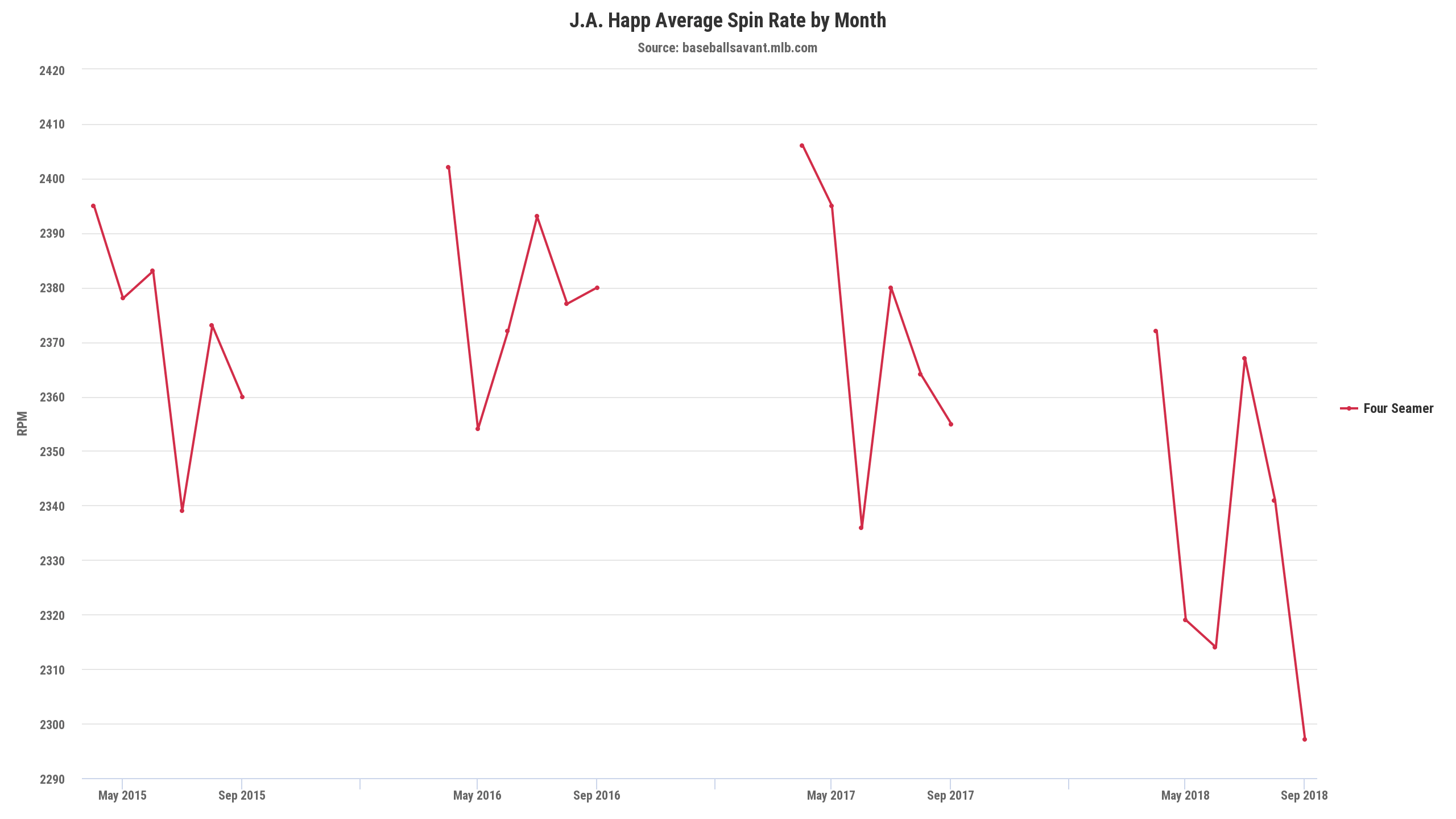
J.A. Happ’s last start began like a familiar tune. He surrendered two home runs in the first two innings, tacking on to the four he had already allowed in just over twelve frames to begin the year. Yet, Happ settled down and was able to reach the seventh inning without much issue. Maybe the struggling Red Sox were the reason he managed to soldier through after appearing to be on the ropes early on. Or, perhaps an in-game adjustment kept him alive.
It’s been well documented that Happ relies heavily on his fastball. He’s made a career of throwing his hard stuff about three quarters of the time. Although Happ has never lit up a radar gun, he’s been particularly successful with his four-seamer because of his command and the pitch’s high spin rate.

On Wednesday, Happ may have reached a breaking point with the four-seamer. To date, all six dingers the veteran has allowed have been against that pitch. It sure seems like that swayed him to make a change right away. Beginning in the second inning, Happ ramped up on his sinker and slider and eschewed the four-seamer.

For dramatic effect, take a look at the comparison of his four-seam and sinker usage by game since 2017:

It’s generally not a great idea to make sweeping conclusions about results over just a few innings, especially against a scuffling Boston team, but the data here is pretty convenient. Happ pitched much better once he ditched his trademark offering. That doesn’t make this approach a panacea for his early season woes, however. Really, the more important aspect of Happ’s game to analyze is his four-seamer. After all, it’s what made him a good pitcher in the first place. Does he really need to abandon it now?
| Four-Seamer | 2018 | 2019 |
| Velocity | 92.3 | 91.4 |
| Spin Rate | 2334 | 2363 |
The good news is that his spin rate is steady. He’s never been a hard thrower, rather, deception has always been the key for the pitch. Throwing high spin rate fastballs up in the zone generally makes for plenty of pop-ups and whiffs. He’s still targeting that section of the zone this season, similar to last year.
The not so good news is his pitch speed. It’s down a hair under one mile per hour compared to last year. Granted, it’s April, so there’s time to build that back up as the weather warms up. That being said, while Happ usually adds velocity as the season goes on, this year’s starting point is lower than ever before.

He may be able to approach the velocity he had at the very end of last year (which was already trending downward!), but approaching 93 MPH on the gun reliably seems out of the question.
Velocity may not be the name of the game for Happ, but losing a tick certainly can sap some of the offering’s effectiveness. Spin rate can only do so much, and ostensibly, is not as helpful when other pitch traits decline.
We already know that Happ’s slider and changeup are mediocre at best, so he’s not going to morph into the left-handed version of Masahiro Tanaka. But, if he can’t find his lost four-seam velocity, he may need to adapt like he did in his past outing against the Red Sox. Fortunately, he could learn a thing or two from his teammate, CC Sabathia, who’s made a living throwing sinkers and cutters over the last couple of years. Maybe Happ was serious when he asked this question to Sabathia:
CC Sabathia was holding his media session when a loud voice popped up from the back of the crowd.
“CC, J.A. Happ here, asking for a friend. How were you able to paint the corners in your first start back?”
(Happ was using a can of Red Bull as a microphone)
— Bryan Hoch (@BryanHoch) April 13, 2019
I can’t tell you if Happ can be successful as a sinkerballer going forward. It certainly worked over the course of a few innings, but perhaps that just caught the Red Sox off guard. Furthermore, there’s no assurance that he’s going to continue that approach his next time out. Even if he does, opponents should be better prepared for it. Either way, Happ is going to have to figure out one of two things: how to pitch with diminished four-seam velocity, or how to regain a mile per hour on it.













